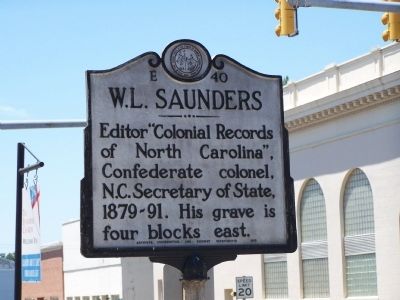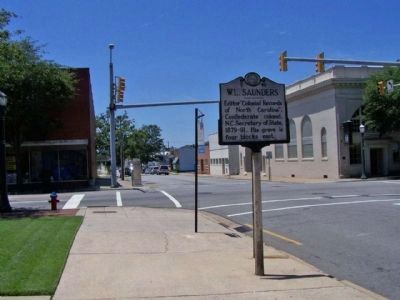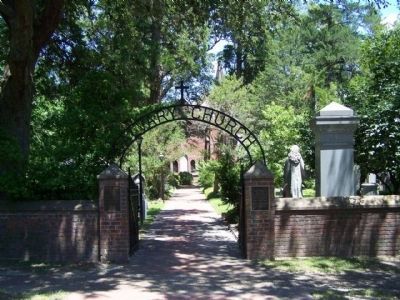Tarboro in Edgecombe County, North Carolina — The American South (South Atlantic)
W.L. Saunders
Erected 1949 by North Carolina Office of Archives & History. (Marker Number E-40.)
Topics and series. This historical marker is listed in these topic lists: Cemeteries & Burial Sites • Communications • War, US Civil. In addition, it is included in the North Carolina Division of Archives and History series list.
Location. 35° 53.844′ N, 77° 32.066′ W. Marker is in Tarboro, North Carolina, in Edgecombe County. Marker is on West St. James Street near Main Street (Business U.S. 64). Touch for map. Marker is in this post office area: Tarboro NC 27886, United States of America. Touch for directions.
Other nearby markers. At least 8 other markers are within walking distance of this marker. W.D. Pender (a few steps from this marker); Henry T. Clark (a few steps from this marker); John C. Dancy (a few steps from this marker); Courthouse Square (within shouting distance of this marker); Knights of Labor (within shouting distance of this marker); The 1999 Flood (about 400 feet away, measured in a direct line); Edgecombe County Veterans Memorial (about 600 feet away); George H. White (about 800 feet away). Touch for a list and map of all markers in Tarboro.
Regarding W.L. Saunders. “I decline to answer.” Those words are inscribed on the tombstone of William Laurence Saunders (1835-1891) at Calvary Episcopal Church in Tarboro. The Confederate veteran, North Carolina Secretary of State, and editor of the ten-volume Colonial Records of North Carolina invoked the Fifth Amendment over 100 times in the course of Congressional investigations into Ku Klux Klan activity in the state. The stance earned him respect of many of his contemporaries but, in the modern era, has proven to be a blemish on a life of notable achievements.
Born in Raleigh, Saunders graduated from the University of North Carolina in 1854. A building in the heart of the Chapel Hill campus bears his name. He tried his hand at the law and at journalism before enlisting in the Confederate army. He rose to a colonelship and commanded the 46th Regiment, North Carolina Troops. Wounded at the Battle of the Wilderness, he took a minie ball in the mouth, thereby permanently impairing his ability to speak clearly.
His complicity in the activity of the KKK (historian J. G. deRoulhac Hamilton indicates that he was the head of the Invisible Empire in the state) led the Congressional committee to call him as witness in 1871. The following year he joined his brother-in-law Joseph Engelhard in editing the Wilmington Journal, a leading voice for the Democratic Party. When
Engelhard was elected Secretary of State, Saunders followed him to Raleigh. When Engelhard died, Saunders succeeded him and went on to reelection in 1880, 1884, and 1888. Suffering from crippling rheumatism, Saunders was confined to a wheelchair after 1880.
Saunders’s major and lasting contribution was to history rather than journalism or politics. With the discovery in 1879 in the Capitol of a cache of documents, Saunders dedicated himself to editing the records for publication.
(North Carolina Office of Archives & History)
Credits. This page was last revised on November 29, 2019. It was originally submitted on August 28, 2011, by Mike Stroud of Bluffton, South Carolina. This page has been viewed 512 times since then and 25 times this year. Photos: 1, 2. submitted on August 29, 2011, by Mike Stroud of Bluffton, South Carolina. 3. submitted on July 23, 2011, by Mike Stroud of Bluffton, South Carolina.


